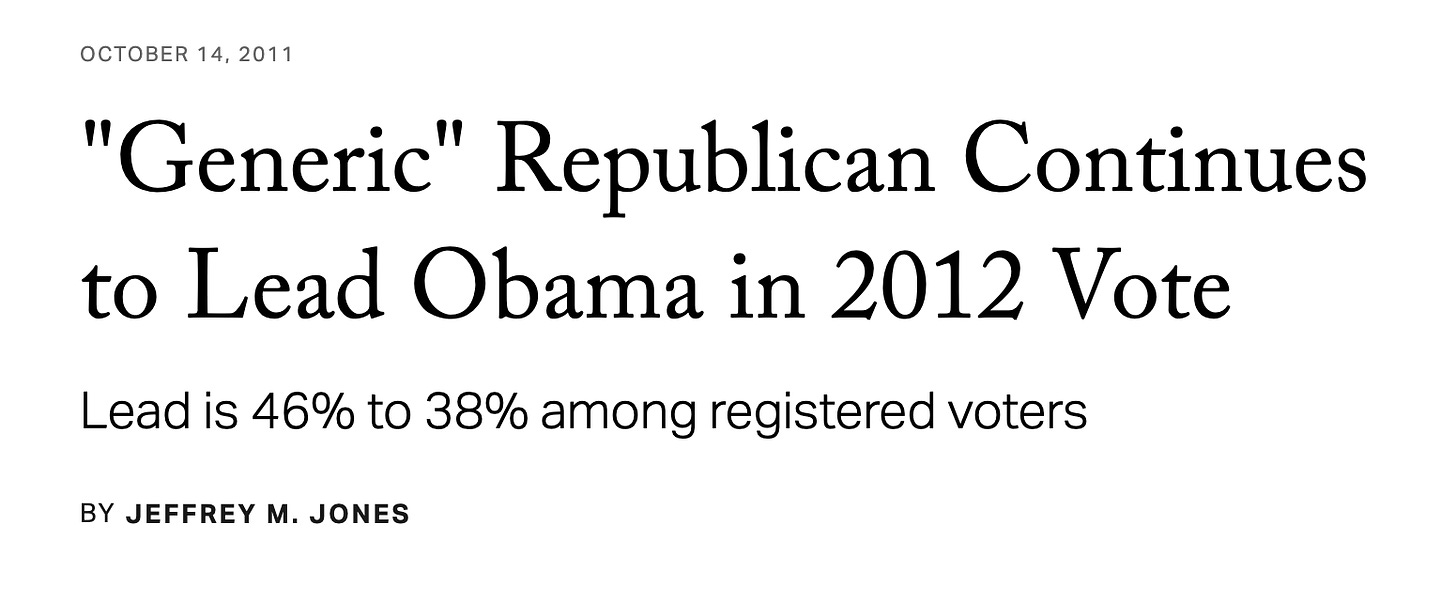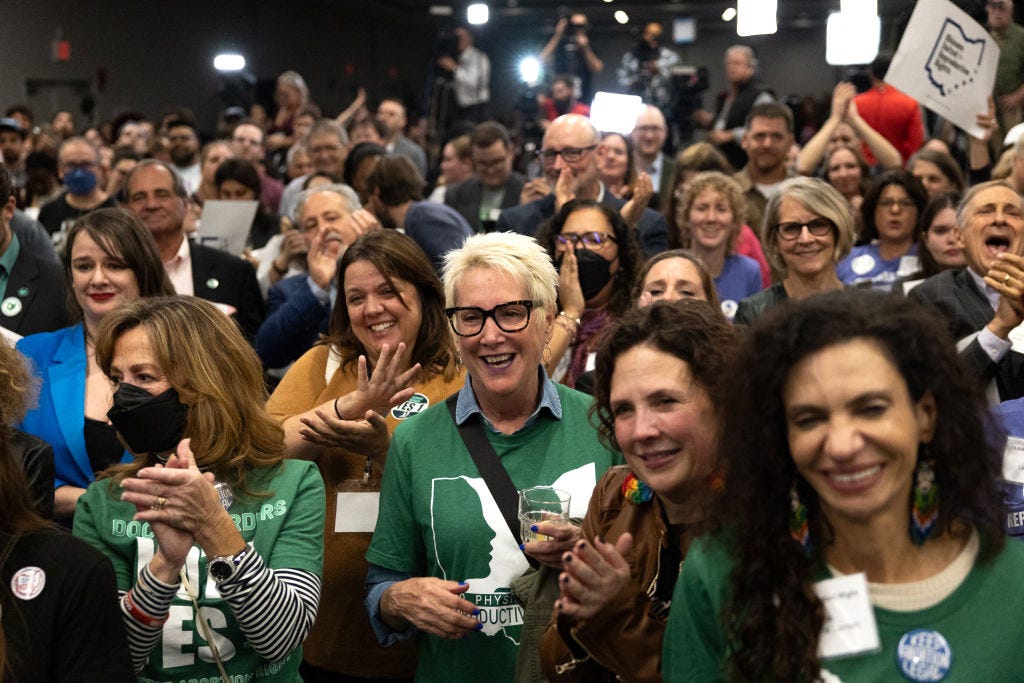Covering the Election: the One-Year Countdown Begins.
Everyone was 'surprised' by Donald Trump coming out ahead in 2016. In elections since then, including this week's, the 'surprise' has consistently run the other way. Hey, fellow reporters: Listen up!
In Ohio on Tuesday night, supporters celebrating the victory of Issue 1, which made reproductive-choice rights part of the state constitution. It was one of many “surprisingly” large victories for Democrats and progressives in post-2016 elections, and of similarly “unexpected” setbacks for GOP culture-warriors once exposed to voters outside the MAGA base. What should the press learn from these repeated surprises? (Photo Megan Jelinger / AFP via Getty Images.)
After yet another round of election “surprises” this week, showing yet again more strength than mainstream media had anticipated for Democratic candidates and progressive initiatives, and more recoil against MAGA forces1, here are several reminders of how the press might recalibrate for the year ahead.
An extra word of context: I am a fan of CBS Sunday Morning. This past Sunday I was part of a closing segment on the show, marking the one-year countdown to Election Day, 2024. Robert Costa of CBS talked with me and Marianna Sotomayor, of The Washington Post, about how the press should gear up this time.
I hope you’ll watch the segment.
But during it, and since, I’ve been thinking about that evergreen subject, how the press adjusts its venerable instincts and assumptions to these unusual times.
1) Predictions: cut way, way, way back on them. They’re useless, and worse.
The political press is very bad at forecasting how elections will turn out. Its track record is worse than for other professional groups whose supposed expertise is predicting future outcomes. Weather forecasters, let’s say. Or bookies. Or economic analysts or military strategists. And the gap appears to be widening. Weather forecasts are stunningly more precise than a generation ago.2 Political prognostications seem if anything worse.
I’ll give some examples in a moment. But let’s jump ahead to the implications of political experts being repeatedly “surprised” by electoral results.
-One response to this pattern of mismatch would be to try even harder to fix the forecasts. News organizations could commission more polls, sponsor more focus groups, send more reporters to diners or county fairs, and give reporters who cover politics even more prominence on the staff.
-The other approach would be to cut losses, scale back on this doomed enterprise, and invest scarce resources in other ways
Naturally I vote for Option Two: Less time guessing about what could happen a year from now. More skill, passion, support, and prestige within journalism for people who can enlighten us about what has just happened, and what is happening now. Not what might be, but what is.
A few illustrations of the pointless wrongness of most political forecasts, especially those driven by the news of some recent poll:
Four days ago, exactly one year before the 2024 elections, the New York Times gave huge front-page, lead-story play to polls it had commissioned (along with Siena College), showing that Joe Biden was running far behind Donald Trump in five swing states.
Is Biden doomed? Will this story “last”? Maybe, and maybe. But remember:
At just this point one year before his 2012 re-election run, Gallup reported that Barack Obama continued to run eight points behind a “generic Republican” opponent.
-A year later, Obama won by 126 Electoral Votes, and a 51%/47% margin in the national vote.


At about this point one year before his 1984 re-election run, Gallup reported that Ronald Reagan trailed Democratic Senator John Glenn by six points in a head-to-head match—and was in a statistical tie with former Vice President Walter Mondale, 44% (Reagan) vs 43% (Mondale).
-A year later, Reagan beat Mondale by 512 Electoral Votes (not a typo) and a landslide 59%/41% national vote.
New York Times headline, September 4, 1983. At just this point one year before his 1996 re-election run, Bill Clinton was reeling from the Democrats’ historic wipeout in the 1994 midterms, and from a year’s worth of presidential approval ratings mostly in the 40s.
-A year later, Clinton won by 220 Electoral Votes and a nine-point national vote margin.3And in more recent times: Just one day before the recent 2022 midterms, the national press ran front page stories about the Democrats’ grim prospects as they braced for an all-but-certain “Red Wave.”
-One day later, Joe Biden’s Democrats solidified their hold on the Senate, picked up two governorships, and lost fewer House seats than other first-term incumbents since John F. Kennedy’s time. And this came after widespread media “surprise” that voters in Kansas had supported an abortion-rights referendum, followed by voters in Wisconsin and elsewhere voting the same way.
You get the idea. Does any of this mean that Biden can take re-election for granted, just because polls show him trailing now? Obviously not. After all, Jimmy Carter was trailing in the polls a year before his re-election run—and went on to lose.
But it is a reason to wonder about the entire enterprise of poll-driven stories and weekly reports on Who’s Up / Who’s Down. These breathless dispatches are writ in water. No one will ever consult them for guidance on our era or its trends—except, as I am doing here, as illustrations of misplaced pundit certainty.
2) About these polls: use them for ‘climate,’ not ‘weather.’
We’ve heard the mantra: Climate is the year-by-year trend. Weather is the chance of rain tomorrow.
Most polls are weather. Has Nikki Haley gained three points on Ron DeSantis? Could Ramaswamy crawl back up? And how is Joe Biden “doing” versus two weeks ago, or two months?
The polls, like weather reports, barely matter a day or two later. Those that are useful are about climate, in the political sense. How will the country change as the Boomers age out?4 As demography and ethnicity shift? As the electorate cares more about, say, environmental responsibility than “the crisis at the border!” or other staples of Fox’s aging-out viewership?
There’s a structural problem of polls, for journalism. Speaking as a one-time newsmagazine editor, I know that these polls (like the ones the NYT recently trumpeted) can be godsends for our business. They’re news! They’re the peg for stories! DeSantis is gaining—no, this week it’s Nikki Haley! Etc.
You can base a “news” story on any of these results. But—in my view—nearly all of these stories are pointless. And—confirmed by views beyond my own—virtually none of them seems “significant” within days after being published, because they have so little long-term bearing on election results or national trends.
Why this disconnect? Because poll-based stories get oomph from things that most political reporters believe as part of their DNA, but that don’t apply to the world at large.
The main mismatch is reporters’ difficulty in recognizing that most people don’t spend their time thinking about the next election, as political reporters naturally do. We politics fans pay attention to week-by-week ups and down in “momentum.” Most people have other things to do. Asking them their preference a year before the election is like asking me about the next World Cup, whenever that will be.




